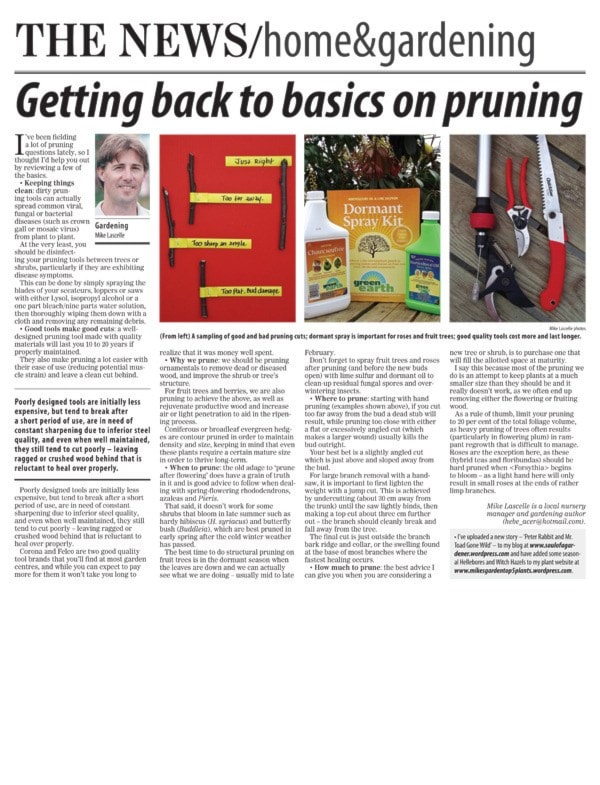I’ve been fielding a lot of pruning questions lately, so I thought I’d help you out by reviewing a few of the basics.
• Keeping things clean: dirty pruning tools can actually spread common viral, fungal or bacterial diseases (such as crown gall or mosaic virus) from plant to plant.
At the very least, you should be disinfecting your pruning tools between trees or shrubs, particularly if they are exhibiting disease symptoms.
This can be done by simply spraying the blades of your secateurs, loppers or saws with either Lysol, isopropyl alcohol or a one part bleach/nine parts water solution, then thoroughly wiping them down with a cloth and removing any remaining debris.
• Good tools make good cuts: a well-designed pruning tool made with quality materials will last you 10 to 20 years if properly maintained.
They also make pruning a lot easier with their ease of use (reducing potential muscle strain) and leave a clean cut behind.
Poorly designed tools are initially less expensive, but tend to break after a short period of use, are in need of constant sharpening due to inferior steel quality, and even when well maintained, they still tend to cut poorly – leaving ragged or crushed wood behind that is reluctant to heal over properly.
Corona and Felco are two good quality tool brands that you’ll find at most garden centres, and while you can expect to pay more for them it won’t take you long to realize that it was money well spent.
• Why we prune: we should be pruning ornamentals to remove dead or diseased wood, and improve the shrub or tree’s structure.
For fruit trees and berries, we are also pruning to achieve the above, as well as rejuvenate productive wood and increase air or light penetration to aid in the ripening process.
Coniferous or broadleaf evergreen hedges are contour pruned in order to maintain density and size, keeping in mind that even these plants require a certain mature size in order to thrive long-term.
• When to prune: the old adage to ‘prune after flowering’ does have a grain of truth in it and is good advice to follow when dealing with spring-flowering rhododendrons, azaleas and Pieris.
That said, it doesn’t work for some shrubs that bloom in late summer such as hardy hibiscus (H. syriacus) and butterfly bush (Buddleia), which are best pruned in early spring after the cold winter weather has passed.
The best time to do structural pruning on fruit trees is in the dormant season when the leaves are down and we can actually see what we are doing – usually mid to late February.
Don’t forget to spray fruit trees and roses after pruning (and before the new buds open) with lime sulfur and dormant oil to clean-up residual fungal spores and overwintering insects.
• Where to prune: starting with hand pruning (examples shown above), if you cut too far away from the bud a dead stub will result, while pruning too close with either a flat or excessively angled cut (which makes a larger wound) usually kills the bud outright.
Your best bet is a slightly angled cut which is just above and sloped away from the bud.
For large branch removal with a handsaw, it is important to first lighten the weight with a jump cut. This is achieved by undercutting (about 30 cm away from the trunk) until the saw lightly binds, then making a top cut about three cm further out – the branch should cleanly break and fall away from the tree.
The final cut is just outside the branch bark ridge and collar, or the swelling found at the base of most branches where the fastest healing occurs.
• How much to prune: the best advice I can give you when you are considering a new tree or shrub, is to purchase one that will fill the allotted space at maturity.
I say this because most of the pruning we do is an attempt to keep plants at a much smaller size than they should be and it really doesn’t work, as we often end up removing either the flowering or fruiting wood.
As a rule of thumb, limit your pruning to 20 per cent of the total foliage volume, as heavy pruning of trees often results (particularly in flowering plum) in rampant regrowth that is difficult to manage. Roses are the exception here, as these (hybrid teas and floribundas) should be hard pruned when <Forsythia> begins to bloom – as a light hand here will only result in small roses at the ends of rather limp branches.
Mike Lascelle is a local nursery manager and gardening author. Email him at hebe_acer@hotmail.com.
Blog
• I’ve uploaded a new story – ‘Peter Rabbit and Mr. Toad Gone Wild’ – to my blog at www.soulofagardener.wordpress.com and have added some seasonal Hellebores and Witch Hazels to my plant website at www.mikesgardentop5plants.wordpress.com.
